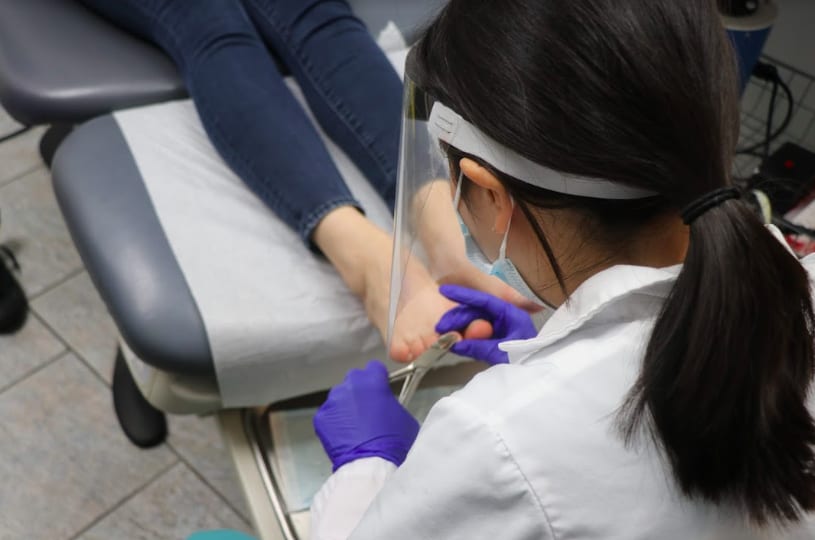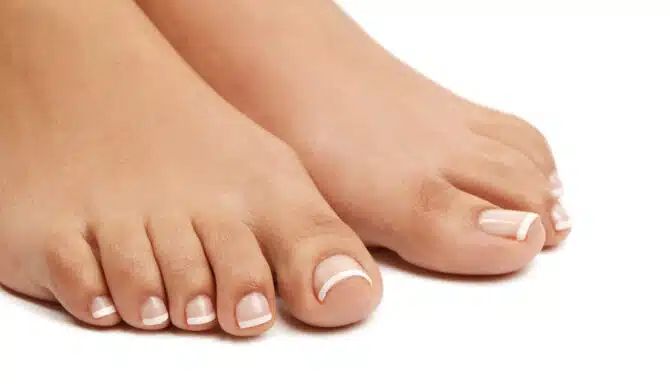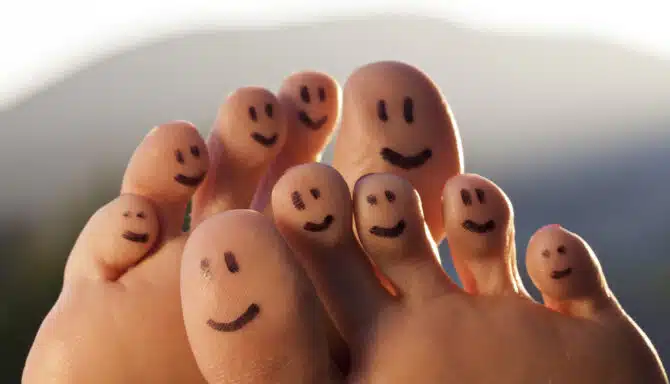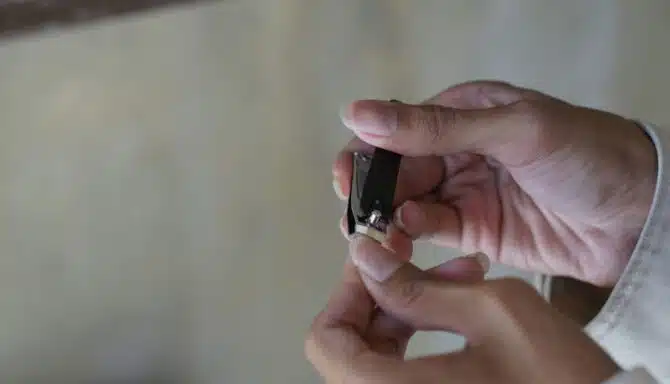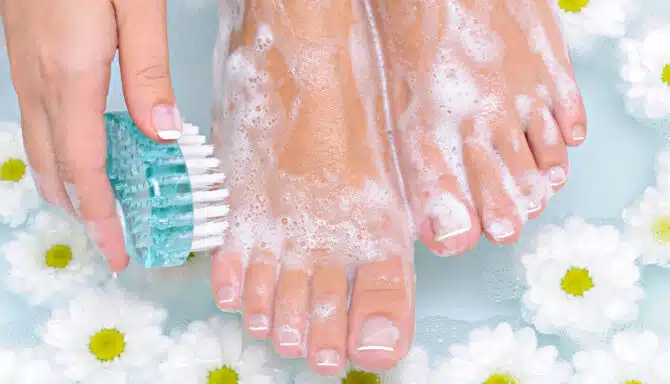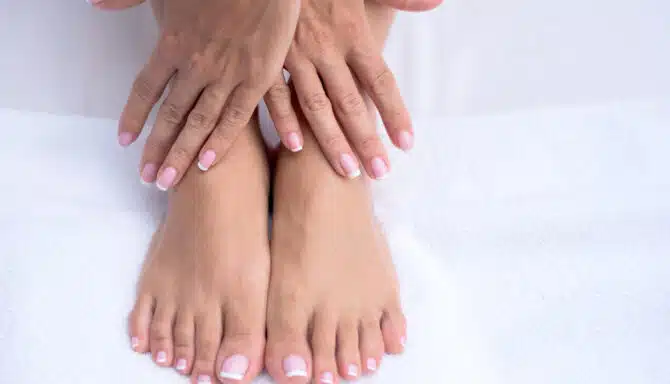September 2, 2024
Ingrown toenails can be more than just a foot problem. Quite frankly, they're annoying. They can also lead to significant discomfort and even serious complications if not addressed properly. Many people don’t even fully understand what they are or what “ingrown” really looks like, so recognizing ingrown toenails early is crucial! This will allow for prompt, effective and safe ingrown toenail treatment, which will reduce your risk of infection and help you avoid more invasive procedures.
Recognizing Ingrown Toenails
So, how can you tell if you’re dealing with an ingrown toenail? The first symptoms include pain and tenderness along the side edge of your toenail (the exact location is the called the paronychium, or the soft tissue border around the nail), typically on the big toe. Why the big toe? It is larger and more vulnerable! It withstands the most damaging effects from poor foot care habits (more on that later).
You might also notice swelling, redness, and warmth in the affected area. If the condition progresses, pus may develop, indicating an ingrown toenail infection. Catching these signs early is key to avoiding further issues.
Visually, it may look curved or embedded, or simply like a tiny, strange nail growth attached to the main nail. You may also see skin growing over the nail.
Ingrown Toenails Causes
Ingrown toenails result from seemingly innocent routines that over time, damage your foot health.
These include improper nail trimming — cutting nails too short or rounding the edges (many people do this for aesthetics but it's a big no-no!) which encourages the nail to grow into the skin. Tight shoes that squeeze the toes together (your feet may be wider than you think), as well as injuries to the toenail, are also common culprits. In some cases, genetics may play a role: some people's natural nail shape and growth pattern may make them more predisposed to developing ingrown toenails, like involuted or pincer toenails.
Knowing these causes gives you the upper hand in preventing ingrown toenails before they start.
Preventing Ingrown Toenails
Wherever possible, prevention is always better than cure.
By trimming your nails straight across, wearing shoes that fit properly, and keeping your feet clean, you can significantly reduce the risk of developing ingrown toenails and a corresponding infection.
If you’re unsure how to cut your toenails properly, especially if you have conditions like diabetic neuropathy, seeking help from a chiropodist for a medical pedicure can be a smart choice. People with diabetes need to be extra vigilant about foot care, as their condition can make them more susceptible to complications from ingrown toenails. Click here to see how a deceptively minor laceration can turn into an ulcer.
Regularly checking your feet, especially if you’re prone to ingrown toenails, is also an essential part of care.
Treating Ingrown Toenails
For mild cases in the early stages, soaking your foot in warm water for 15 minutes 2 times a day can soften the skin and reduce swelling. After, you can wedge a wet piece of cotton under the corner of the toenail to help lift the ingrown portion while it heals. But beware—safe ingrown toenail treatment at home requires careful handling to avoid making things worse. And whatever you do, do not attempt to cut the toenail or dig the ingrown portion out.
If there's no improvement in 3 days, or if you're experiencing any pain or irritation, seeking professional ingrown toenails treatment from a Toronto chiropodist is a better idea. For safe ingrown toenail treatment, always see a chiropodist - do not go to a salon. If you try to treat your ingrown toenail at home (or at a salon), you can get an infection and make things worse. Plus, when you do ultimately see the chiropodist, the chiropodist will have to cut the toenail even shorter than they normally would in order to fix the DIY job. This lengthens the healing process.
If the pain is severe and you’re waiting for your chiropody appointment, try the following tips for ingrown toenail relief:
Soaking your feet in warm (not hot) water with Epson salts: The salt is a natural disinfectant and will help clean the wound so that it doesn't get infected and become further irritated.
If there are signs of infection (i.e.: bleeding, discharge), wear a band-aid over the ingrown toenail when you're wearing shoes and socks to prevent bacteria from getting stuck in the wound.
Try over-the-counter pain relievers like Tylenol or Ibuprofen
These can offer temporary comfort before you can address the root cause and follow proper treatment guidelines.
Safe Ingrown Toenail Removal
Safe ingrown toenail removal with a licensed chiropodist is always the best way to go. Most ingrown toenails do not need to be surgically removed: a chiropodist can typically safely remove it non-surgically with sterilized tools in a sanitized, safe environment. They can also cut the toenail in a way to prevent it from coming back.
In severe cases (like if you attempted to fix your own ingrown toenail and it got infected, or your ingrown toenail keeps coming back), safe ingrown toenail treatment may involve a minor surgical procedure from a chiropodist called a total or partial nail avulsion.
August 15, 2024
Whether they're discoloured, cracked, ingrown, curly, or on the verge of falling off, toenail anatomy can be fragile and our nails can do funny things. A less commonly discussed issue is a secondary toenail. Also known as an accessory toenail or petaloid toenail, a secondary toenail is a sneaky little extra nail twin that grows alongside or beneath the pinky toenail. This abnormal toenail growth can be concerning, so it’s natural to have questions.
Signs You Have a Secondary Toenail
It’s important to know the difference between an ingrown toenail and an accessory toenail.
First, ingrown toenails can grow on any toe, whereas a secondary toenail appears on the fifth, smallest toe.
Ingrown toenails are also far more common, and pierce the skin rather than growing alongside the nail.
Secondary toenails are thin in nature and often don’t cause pain, infection or swelling like ingrown toenails do (although it is possible).
Lastly, ingrown toenails form on the side of the nail unit, whereas secondary toenails grow underneath the proper nail.
What Causes a Secondary Toenail?
A secondary toenail is a rare phenomenon.
It often makes an unexpected appearance after trauma or injury to the nail bed. You may notice your nail growing differently after stubbing or hurting it. Chronic pressure from tight shoes or less-than-perfect nail trimming can also coax this extra nail into existence.
Do You Need Surgery For Secondary Toenails?
Studies show that the treatment of choice for this extra pinky toenail is an excision, especially if it’s infected. A partial or total nail avulsion from Toronto’s Feet First Clinic may be the solution you need, but you’ll have to schedule a proper foot assessment to determine the best course of action.
Treatment of accessory toenails targets the original toenail, not the second one. The second toenail should grow properly after the “main” nail is removed.
August 1, 2024
A toenail falling off can be uncomfortable and cause concern about damage to the toenail. The goal is to preserve the toenail's state to prevent further damage.
Fortunately, if you take a few proactive steps, you can reduce the discomfort and promote healing. Here are our six tips for managing a toenail on the verge of falling off.
1. Keep the toenail area clean and dry
Wash the toenail gently and often. We recommend using mild soap and water to keep it clean. Next, pat dry so as not to snag the toenail with a towel.
2. Cut the nail carefully and slowly
Use clean, sterilized nail clippers to remove any dangling or loose portions of the toenail. Cut straight across without digging into the surrounding skin. The goal here is to prevent further snagging or tearing down the road. Improperly cutting your nail may also increase your risk of an ingrown toenail.
In addition to trimming the toenail straight across, you should trim the toenail slowly. Don't over-cut it. Be patient with toenail growth. (It may take months to a year for a nail to fully grow out.) If in doubt, let our toenail specialists in Toronto trim your toenails for you as part of a medical pedicure.
3. Use a non-stick bandage to protect the area
We recommend applying a bandage or non-sticky wrap to your toe. (Adhesive can attach itself to the toenail and be difficult to peel off without grabbing onto it.) A protective layer keeps an otherwise exposed nail bed safe. Replace the bandage regularly and keep the area dry to promote healing.
4. Antiseptic ointment is your friend
Use an antiseptic ointment or petroleum jelly on the exposed nail bed to keep it moisturized and prevent infection. This may help soothe any discomfort from the loose toenail.
5. Choose comfortable and roomier footwear
You'll want to reduce pressure as much as possible to prevent a loose toenail from falling off. Given that we wear footwear so often, finding shoes with ample fit can help prevent further damage to the toenails.
6. Avoid intense activity
Reduce your activity level if it puts excessive pressure or strain on the affected toenail. For instance, running or high-impact sports like soccer could increase the risk of the toenail getting snagged or torn off. Give your toe some rest, and return to physical activity gradually.
July 11, 2024
There's always the right tool for the job. Using each tool for its intended purpose is best, or you risk doing more damage than good. That's why fingernail clippers and toenail clippers exist.
To understand why, it's important to understand the difference between toenails and fingernails. Toenails are thicker, harder, and grow slower than fingernails because your feet and hands serve different functions. Toenails also have a greater surface area.
In this blog post, we explain why you should avoid using fingernail clippers for your toenails and opt for toenail clippers exclusively.
Reduce the risk of bacterial or fungal contamination
For one, separating your nail tools prevents contamination and possible spread of bacteria and fungus. Given how exposed your hands are every day, you wouldn't want to spread any bacteria to your feet.
When in doubt, clean your clippers with 70%—90% isopropyl alcohol.
Fingernail clippers may not work on toenails
When looking at fingernail vs. toenail clippers, the size difference is stark. Fingernail clippers are smaller, narrower, and curved. Toenail clippers are larger, wider, and straight across, as you should trim your toenails straight across. Cutting them with a curved edge increases your risk of ingrown toenails.
If you want more guidance on choosing the tool for your toenails, read our blog post on our top choices for toenail clippers.
Limit the risk of cracking and damaging your toenails
Using sharp, rigid toenail clippers makes trimming easy and more effective. Using fingernail clippers means you'll need to apply more pressure to cut the nail and risk damaging or even cracking the toenail.
If you don’t have the right tools, enough time, or simply the confidence to focus on a nail trim, try a medical pedicure instead. It includes the right nail trimming procedure and includes moisturization, thorough cleaning, and more. Before the nail trim, a chiropodist also examines your feet for other foot conditions.
Prevent ingrown toenails
You'll also notice the curvature of fingernail vs. toenail clippers. Fingernail clippers are curved and meant to follow the contours of your fingernails. On the other hand, toenails are plateaued and should be cut straight across. Using a curved tool on your toenails puts you at risk of jagged edges, nail splitting, or could be a root cause of ingrown toenails.
If you wish, use a nail file to round the edges. This tool is necessary for properly smoothing the edges of the nails. After the trimming, there will likely be some jagged edges, sharp corners, and “spikes.”
March 21, 2024
Foot hygiene and solid foot care tips are your secret weapons for happy and healthy feet! Everyone should practice a clean and healthy foot routine, but those with foot conditions such as diabetes or chronic fungal infections should be extra vigilant. Today we’ll talk about the best foot cleaning practices and how to implement them into your daily foot care routine.
Foot Health Essentials: How to Keep Your Feet Clean and Protected
Foot hygiene is pretty straightforward stuff! But you may make some minor missteps along the way. Take a look below at the best ways to wash, dry and moisturize your feet.
Washing Your Feet
Wash your feet daily with natural, gentle soaps in warm water. Hot water can negatively impact your blood circulation by increasing the size of the blood vessels, so be careful with temperatures.
Moisturizing Your Feet
Use lotion on the bottom and top of your feet. This can help you prevent calluses, corns, cracked heels, and more. Natural, fragrance-free and medicinal lotions are your best bet (try Gehwol at Feet First Clinic!). If you have diabetes, be extra careful to avoid putting lotion in between your toes; it could cause an infection depending on the lotion. Fungal infections also favour wet toes and tend to appear there.
Keeping Your Feet Dry
Thoroughly dry your feet after washing them. If you get lazy and keep them damp, you are again more likely to attract contagious fungal infections (they love moist environments!).
Invest in products that help manage foot dampness and repel excess moisture. These include moisture-wicking socks (also remember to change your sock frequently!), waterproof shoes and boots, running shoes with perforated holes in the uppers, and various foot deodorant products (creams, powders, sprays). These products are also great for preventing foot odour.
Toenail Care and Foot Hygiene
Keeping your nails in top shape is an important element of foot hygiene. Follow these nail care tips to protect your nails and keep them clean and strong.
Cut your nails straight across with high-quality nail clippers. Don’t try to shape them during this stage!
Avoid cutting your nails too close to the skin; this will cause ingrown toenails.
Gently use a nail file for subtle shaping.
Don’t try to cut your own cuticles if you’re prone to infections. They protect the nails and getting rid of them improperly may welcome fungi.
Schedule a medical pedicure for professional care and a cleaning of hard-to-reach areas.
March 18, 2024
Toenail care is your shield from future foot issues. Foot conditions affecting the toenails can lead to infections, fungus, brittle and damaged nails, pain, bleeding and more. But you have the power to prevent these complications! By investing in proper footwear, learning to trim your nails properly, and more, you can take the reins on your toenail health.
Let's talk toenails!
Preventing Fungal Infections and Other Toenail Conditions
Practice Proper Toenail Trimming
It would be nice to have a professional always trim our nails for us, but sometimes we do have to do toenail care ourselves. To prevent issues or conditions, trim your nails following these two simple steps:
Use nail clippers to trim straight across (very important), avoiding curved edges.
Smooth edges with a nail file if needed.
Keep Your Feet Clean and Protected
Fungal toenails love when you forget to care for your feet.
Make sure you always thoroughly clean and dry your feet before wearing socks and shoes. To go the extra mile and protect from skin issues, moisturize, exfoliate and use a foot file.
Avoid areas where contagious fungal viruses breed and are passed along. These include public pool grounds, public showers, shared locker rooms, and more. If you frequent places like this, always wear shoes.
Pedicure safety and hygiene are also very important when it comes to prevention. Schedule medical pedicure appointments with your chiropodist instead of a cosmetic pedicure to avoid contracting a contagious fungal infection and for a more health-focused experience. Learn more about the difference between a cosmetic and medical pedicure.
Make Healthy Footwear Choices
The link connecting toenail issues and footwear may seem unclear, but picture it this way:
When our shoes are too tight it often means there is not enough room for the toes to spread out naturally. This can wreak havoc on your nails and you also risk annoying ingrown toenails or a cracked toenail. Always buy shoes with enough room in the toe box!
Take it to the next level by looking for running shoes with mesh uppers that allow air to flow inside the shoe. This is a bonus way of keeping your toes fresh and protecting against fungal infections. Check out this handy shoe shopping checklist for even more help!
Toenail Care for Pre-existing Conditions
Anti-fungal Treatments for Toenails
You won’t be able to treat a current fungal infection without using antifungal products or visiting a chiropodist. Products include sprays, ointments and sometimes pills. At times, over-the-counter versions like ClearNails Pro + (available at Feet First Clinic) are enough, but other times, you’ll need a prescription for a persistent infection. Chiropodists can also perform nail debridement, which involves removing the infected part of the nail and thinning the outer layers of the toenail. This allows prescription-strength topical antifungal medication to penetrate the toenail and reach the fungus.
Treating Cracked Toenails
Cracked toenails are more of a nuisance than a serious problem. But messing with your toenails in any way can still cause bleeding and pain. You may be more susceptible to cracks if your nails are weak and brittle.
If you’re looking for some ways to speed up nail growth, but also to strengthen your nails as they are, try these toenail growth tips:
As we've mentioned, trim nails straight across and avoid trimming too close to the skin
Again, wear well-fitting shoes. Tight shoes can disrupt healthy toenail growth.
Protect toenails during physical activities.
Avoid excessive use of nail polish. While polish itself doesn’t slow growth, some types can cause toenail dehydration, making your nails more likely to crack.
Eat a balanced diet for nail health.
Treating Ingrown Toenails
OnyFix is a useful and modern way of treating ingrown toenails. It involves the application of a specialized corrective strip to the affected nail. Nail avulsions can also be a good idea for chronic, severe ingrown nails, and chiropodists may tackle infections using certain draining methods.
Treating Toenail Discolouration
Discoloured toenails are tricky because the colours can vary wildly. Discolouration caused by a fungal infection (green or yellow) may be treated using similar methods as fungal toenails. But if your discolouration is black, blue, purple, or red, this is probably linked to a mild blunt-force trauma injury (like dropping something on your toe). It’s best to schedule a nail care appointment to determine the culprit!


